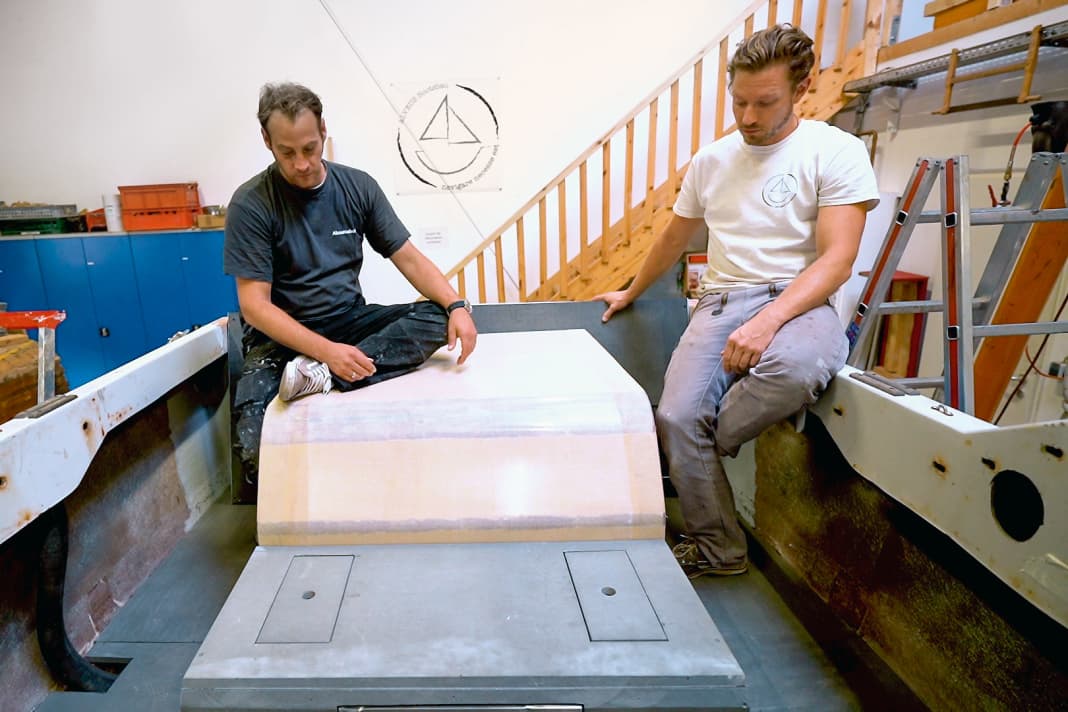





All episodes of the refit project:
- Part 1: Stocktaking
- Part 2: Replacing the rear view mirror
- Part 3: The underwater hull
- Part 4: GRP repairs
- Part 5: Antifouling coating
- Part 6: The motor foundation
- Part 7: The stringer system
- Part 8: The new engine
- Part 9: The new tank
- Part 10: The interior fittings
- Part 11: The interior work continues
- Part 12: The side panelling
- Part 13: Surface treatment and colour
The seats next to the engine compartment are not wide enough for "XXL-sized seats". The conclusion drawn by the refit specialists in the last part of our series is disappointing. The boat builders from Potsdam promised to look for alternatives; we were curious. Unfortunately, the results of the search did not trigger any cheers. Our almost thirty-year-old Conquest 1950 CC remains a four-seater. The plan to implant two additional seats has been cancelled. What a pity!
The current construction plan of the "usual suspects" (meaning Sven Walter, boat builder at M. u. H von der Linden, and Alveus boatbuilding boss Hilmar Dembler-Malik) yesterday and today features a double bench seat in front of the engine box, which offers storage space and room for the installation of a cool box, all built from Coosa composite panels. As a reminder: Coosa composite panels are made from a polyurethane foam filled with continuous glass fibres, which is additionally reinforced with glass roving fabric. Important: Coosa is 40 per cent lighter than plywood and does not absorb moisture. In plain language: there's no rotting!
Service hatches must be integrated into the floor panel and bench seat
The floor plate on which the bench seat is to stand is above the tank, on which the hose connections and tank sensor are installed aft. This means that we need a service hatch at exactly this point in case of a mishap. No problem: measure out the correct position, mark it and cut out a 25 x 25 cm hole. A tip: If you do this properly, the cut-out can then be used as a hatch cover. The GRP bracket, which holds the engine box in position, is glued into the rebate previously milled with the router.
Once the floor panel is in place, the dimensions for the stern bench taken from the boat and sketched out are transferred to the Coosa panels provided. Cut-outs for two hatches (service and storage space) are marked on the top of the bench console and a cut-out for the cool box on the front. Once the "marks have been made", the openings can be sawn out exactly along the lines using a hand-held circular saw and Japanese saw. Please note: Unlike European fine saws, Japanese saws do not work on pressure, but solely on tension. Their extremely thin saw blades enable very fine cuts to be made without a great deal of effort.
The cool box is in place
The side sections, front and top of the bench console are then glued together using adhesive angles and epoxy glue (a mixture of epoxy resin and hardener). Time for finishing touches. In other words, for the frames glued with the same material, on which the cut-outs used as hatch covers rest, and a reinforcing plate screwed to the underside. All made from Coosa composite panels, of course. To ensure that the cool box can be opened and closed without any problems, the (almost) finished bench console now only needs the finishing touches.
Small corrections are all that is needed and the cut-out on the front fits perfectly. A Coosa plate, mounted on the box, ensures the correct installation height and a secure stand. Some people like it cold. That's why we don't place the cool box's compressor behind the box, but right next to it under one of the two service hatches. The refrigeration technician says thank you even before the first inspection. And we look forward to the continuation of our refit series: the interior work on the slip cab.
Video of the refit project
The BOOTE Refit project is supported by


